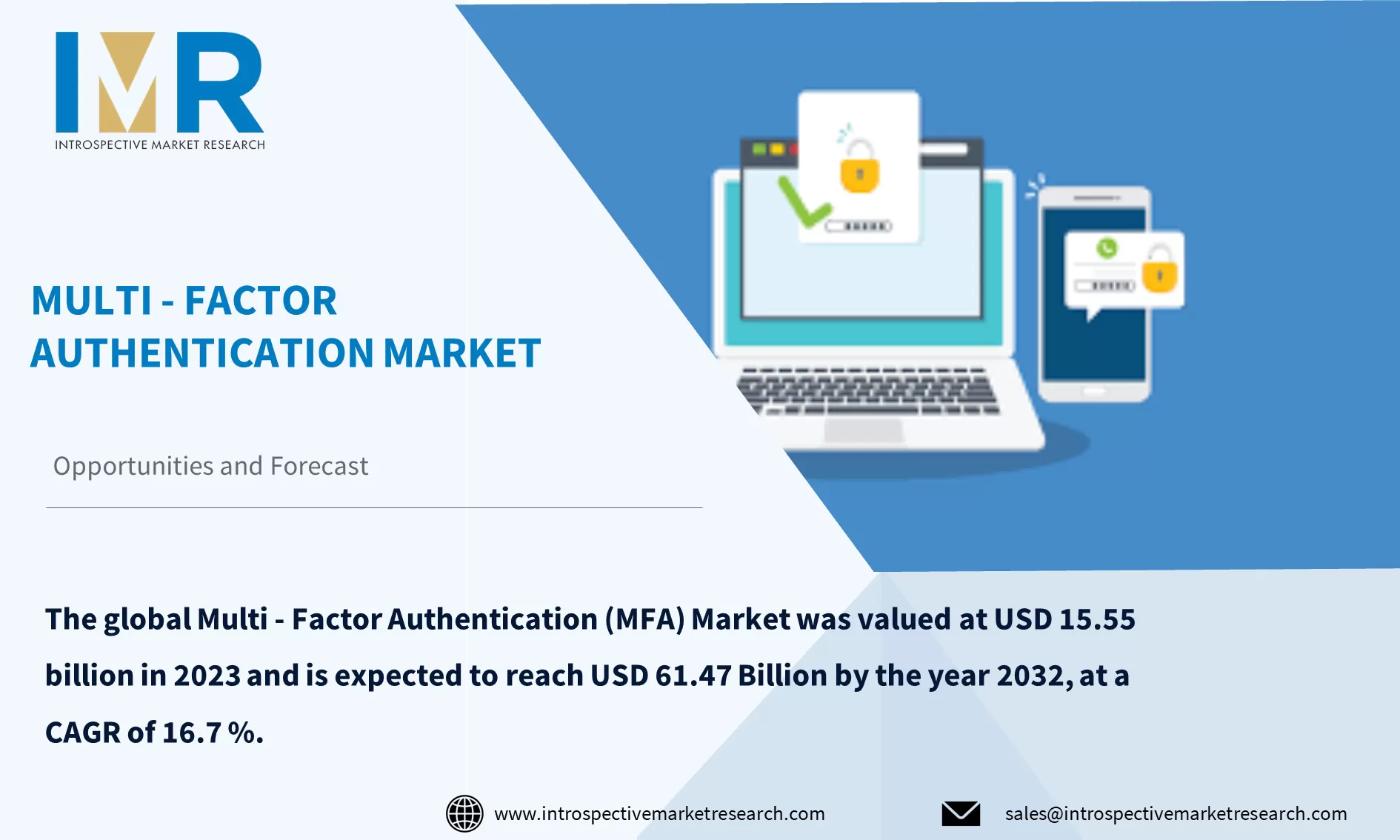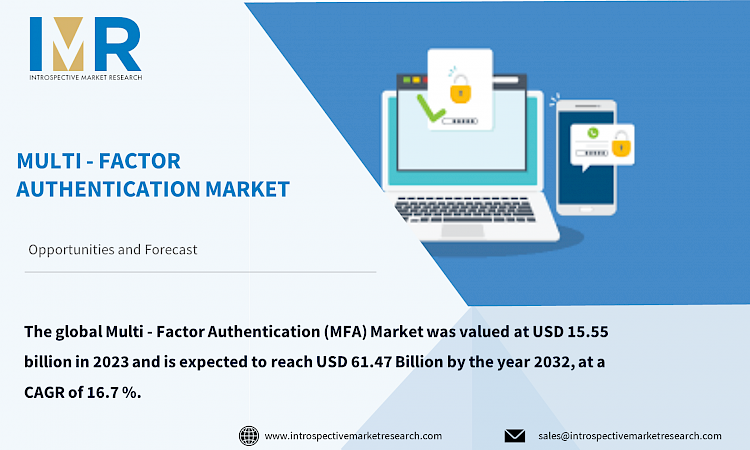Multi - Factor Authentication (MFA) Market
According to a new report published by Introspective Market Research, titled, ?Multi - Factor Authentication (MFA) Market Authentication by Type (Password-Based, Password less), by Component (Hardware, Software, Services), By Model Type (Two-factor Authentication, Three-factor Authentication, Four-factor Authentication, Five-factor Authentication), by End User (Government, Military and Defense, Commercial Security, Travel and Immigration, Banking and Financial Institutions, Others), and Region Global Market Analysis and Forecast, 2024-2032.
The global Multi - Factor Authentication (MFA) Market was valued at USD 15.55 billion in 2023 and is expected to reach USD 61.47 Billion by the year 2032, at a CAGR of 16.7 %.
Multi-factor authentication (MFA) is an authentication procedure that requires a user to provide at least two separate authentication factors to a mechanism to control a resource, such as an application, online account, or VPN, instead of a simple username and password. a combination Multi-factor authentication (MFA) requires users to verify their identity by providing at least two pieces of evidence, such as a password and a temporary access code.
MFA is essential to a strong identity and access management (IAM) strategy. MFA consists of one or more additional authentication factors. Instead of only requiring a username and password, this reduces the likelihood of a cyber-attack. In the digital age, characterized by frequent cyber threats and increasingly sophisticated encryption techniques, relying only on passwords is not enough, as they can be easily damaged and cracked.
MFA eliminates and reduces this risk by requiring users to provide at least two authentication methods, such as a password with fingerprint recognition, a code sent to a mobile phone, or facial recognition. This added protection significantly reduces the likelihood of unauthorized access, improves overall data protection and increases trust in digital communications between platforms and devices.
The main benefit of MFA is to increase an organization's security by asking consumers to identify themselves with something other than a username and password. Although usernames and passwords are important, they are vulnerable to cyber-attacks and can be stolen or misused by third parties and cyber attackers.
Using an MFA factor such as a thumbprint or physical hardware key increases confidence that an organization is protected from cybercriminals. MFA works by requiring additional authentication information (factors). One of the most common MFA problems users face is one-time passwords (OTPs).
OTPs are 4-8-digit codes that customers often receive via email, text message or mobile app. With OTP, a new code is generated regularly or every time an authentication request is sent. The code is generated based on the initial value given to the user when they first log in, and some other factor, which could simply be an incremented counter or time value.
The growing demand for multi-factor authentication systems that enhance the security of businesses and other organizations and their customers is increasing with the development of healthcare, retail, banking, finance, and insurance (BFSI) sectors. Because banks perform various functions such as core banking, trade finance, international payments, and online banking, all of which require secure connections to ensure a smooth user experience and smooth operations.
Multi-factor authentication (MFA) is gaining momentum in the Internet of Things (IoT) ecosystem due to vulnerabilities in traditional single-factor methods, such as weak passwords and lack of direct user interaction on IoT devices. MFA provides a higher level of security by requiring multiple credentials to authenticate users, which extends the scope of authentication.
Global Multi - Factor Authentication (MFA) Market, Segmentation
The Multi - Factor Authentication (MFA) market is segmented based on Authentication Type, by Component Type, by Model type, and by End user.
Type:
The Two Authentication is likely to dominate the Multi ? Factor Authentication (MFA) market over the forecast period. Use of smart cards is increasing. The smart card as a physical component offers multi-level security. Cards created with advanced encryption features are highly resistant to hacking, cloning or counterfeiting. Their anti-knock design, reinforced by built-in security elements such as metal layers and sensors that detect and detect various attacks, guarantees the integrity of the authentication process. Smart cards contain encryption elements that protect stored information and require secure retrieval methods.
The demand and need for smart cards in two-factor authentication is due to their effectiveness in reducing and eliminating the risks of unauthorized use and identity theft. In an environment where cyber threats are growing rapidly, organizations and individuals alike understand the importance of strong security measures. Smart cards not only reliably guarantee the identity of the user, but also protect against various attack vectors. Associating a physical object (smart card) with something known (PIN) creates a strong defense against unauthorized access and protects sensitive digital assets in a cybersecurity environment. Therefore, the introduction of smart cards and 2FA represents a proactive response to evolving threats and highlights their central role in strengthening digital security frameworks.
End User:
Over the projection period, the Banking and Finance category is estimated to account for the largest market share. ? Banks and financial institutions are infinitely vulnerable to cybercriminals. They seek to exploit weaknesses in the banking and financial systems. The uncompromising nature of the banking and financial industry leads to the popularity of MFA, as the compromise of sensitive information can result in significant financial loss and reputational damage. Every company in the banking sector is estimated to cost 15.4 million euros annually due to cyber-attacks.
In banking and finance, individuals use passwords, biometrics, or one-time codes to access accounts and make transactions. In most cases, the goal of the attack is to obtain private user information such as usernames, passwords, credit card numbers, and personal identification numbers, regardless of the attacks.
The biggest problem with old-fashioned logins with usernames and passwords is that hackers can easily access and steal passwords, potentially causing millions of dollars in damage. Automated password-cracking tools are a big problem because of the potential for brute-force cyberattacks, where cybercriminals systematically try different login and password combinations until they succeed. Regulations, such as the FFIEC guidance, require financial institutions to have robust safeguards, such as MFA, to protect and secure customer information and to comply.
Several applications use biometric authentication, fingerprint, face recognition, speech recognition, and retina scanner in banking applications and ATMs. Banks and financial institutions use token-based authentication systems that require customers to use physical tokens or mobile apps to create unique passwords to access an account or confirm a transaction.
Region:
The North American region is expected to lead the worldwide Multi ? Factor Authentication Market. Cyber-attacks, especially identity crimes, significantly affect the United States compared to other regions of the world. Growing cyber threats in the region increase the need for strong security solutions. Stricter regulations such as GDPR and HIPAA require organizations to implement MFA in order to comply. North American governments view cybersecurity as the most critical economic and national security threat. The growing threat of identity theft is a strong driver for the implementation of MFA in several sectors. Because traditional authentication methods can have limitations, MFA provides a robust way to increase security and prevent unauthorized access and identity theft for both organizations and individuals. In the United States, MFA is required for government agencies, and individuals using IDs and PINs for remote access those accessing government websites.
Some of The Leading/Active Market Players Are-
- 3M (U.S.)
- RSA Security (U.S.)
- Okta, Inc. (U.S.)
- Duo Security (U.S.)
- Microsoft Corporation (U.S.)
- IBM Corporation (U.S.)
- Giesecke+Devrient Mobile Security GmbH (Brazil)
- IDTECH (Brazil)
- Auth0 (Czech Republic)
- Yubico (Sweden) and Other Active Players
Key Industry Developments
- In May 2024, RSA will work with Microsoft to secure environments with new external authentication methods. RSA announced that it is strengthening Microsoft environments with an ongoing collaboration that brings additional security to Office environments. The new External Authentication Methods (EAM) feature enables more customers to extend the use of RSA solutions, including RSA authentication and access capabilities, to many other Microsoft environments.
- In September 2023, Microsoft and Oracle will expand their partnership to offer Oracle database services on Microsoft Azure, Oracle's cloud infrastructure. Oracle Corp and Microsoft Corp announced Oracle Database Azure, which offers customers direct access to Oracle database services running on Oracle Cloud Infrastructure (OCI) and deployed in Microsoft Azure data centers.
Key Findings of the Study
- North America is projected to lead the global macro market due to increasing cyber-attacks and strict regulations requiring the adoption of MFA to improve security, especially in the US.
- The banking and finance sector is expected to have the largest market share due to its vulnerability to cyber threats and MFA as the primary defense against sensitive data compromise, financial loss, and reputational damage.
- Two-factor authentication, especially using smart cards, is poised to dominate the MFA market as it effectively reduces unauthorized access and identity theft and enhances security in the face of growing cyber threats.






